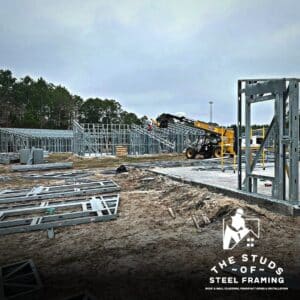Understanding the Assembly and Installation of Steel Studs and Tracks
The assembly and installation of Light Gauge Steel (LGS) studs and tracks is an essential part of commercial construction, offering a durable, precise, and efficient building solution. When used in commercial projects, steel studs and tracks provide superior strength and stability, while also simplifying the construction process. In this post, we’ll walk through the assembly and installation process of steel studs and tracks, highlighting the benefits and best practices to ensure a successful project.
1. Overview of Steel Studs and Tracks in LGS Framing
Before diving into the assembly and installation process, it’s important to understand the basic components of Light Gauge Steel framing:
- Steel Studs: These are vertical framing members that form the structure’s walls. Steel studs provide the main support and are placed at regular intervals to form the building’s skeleton.
- Steel Tracks: Tracks are horizontal framing components that hold the steel studs in place. They are installed at the top and bottom of the wall, creating a secure framework for the structure.
Together, steel studs and tracks form the core framework of commercial buildings, offering both strength and flexibility in design.
2. The Prefabrication Advantage: Faster and More Efficient Assembly
One of the key benefits of using Light Gauge Steel framing is that steel studs and tracks are often prefabricated off-site. Prefabrication offers several advantages during the assembly and installation process:
- Precision-Engineered Components: Prefabricated steel studs and tracks are manufactured to exact specifications, ensuring a perfect fit when they arrive at the job site. This eliminates the need for on-site adjustments and reduces the likelihood of errors during installation.
- Reduced Construction Time: By using prefabricated components, the assembly process becomes much faster. Since the pieces are ready to be installed, on-site labor is minimized, allowing projects to stay on schedule and meet tight deadlines.
- Consistency in Quality: Prefabricated steel components are produced in controlled environments, ensuring that each piece meets quality standards. This leads to greater consistency and fewer defects during construction.
Prefabrication helps streamline the assembly process, reducing costs and improving the overall efficiency of the project.
3. Assembly Process: Installing Steel Tracks and Studs
The assembly process begins with the installation of the steel tracks, followed by the insertion of steel studs. Below is a step-by-step overview of how this process typically unfolds:
- Step 1: Marking and Measuring the Layout
- Before installing the tracks, it’s essential to carefully measure and mark the layout of the walls. This ensures that the tracks are installed in the correct positions and that the studs will be properly spaced.
- Contractors often use chalk lines to outline the placement of the tracks on the floor and ceiling.
- Step 2: Installing the Steel Tracks
- The steel tracks are installed first, typically secured to the floor and ceiling using screws, anchors, or other fasteners. These tracks will hold the steel studs in place.
- Once the bottom track is secured, the top track is aligned and installed directly above, ensuring that the framework is level.
- Step 3: Inserting the Steel Studs
- After the tracks are in place, the steel studs are inserted vertically into the tracks at regular intervals, typically 16 or 24 inches apart, depending on the project specifications.
- The studs are secured to the tracks using screws, ensuring they remain in place and provide the necessary structural support.
- Contractors ensure that the studs are plumb and level, which is crucial for creating straight walls.
- Step 4: Bracing and Reinforcing the Structure
- In some cases, additional bracing or reinforcement may be added to increase the strength of the wall, particularly in high-stress areas or multi-story buildings.
- Once all studs are secured, cross bracing or horizontal framing members may be added to enhance the stability of the wall.
The simplicity of the assembly process, combined with the strength of steel, ensures that buildings framed with LGS components are both durable and efficient to construct.
4. Best Practices for Installing Steel Studs and Tracks
To ensure a smooth and successful installation, it’s important to follow certain best practices when working with steel studs and tracks:
- Use the Right Fasteners: Steel framing requires specialized fasteners, such as self-tapping screws, that are designed for use with steel components. These fasteners ensure a secure fit and help prevent movement or shifting over time.
- Ensure Proper Alignment: Accurate measurements and careful alignment are crucial when installing steel tracks and studs. Ensuring that the tracks are level and the studs are plumb will result in straight, stable walls.
- Plan for Openings and Utilities: When framing walls, it’s essential to plan for openings such as doors and windows. In addition, provisions should be made for routing utilities, such as electrical wiring and plumbing, through the studs.
- Work with Experienced Contractors: Light Gauge Steel framing requires specialized knowledge and skills. Working with contractors who have experience in installing steel studs and tracks ensures that the project will be completed correctly and efficiently.
By following these best practices, contractors can maximize the efficiency of the assembly process and deliver a high-quality finished product.
5. Advantages of LGS Framing for Commercial Buildings
Using steel studs and tracks in commercial construction offers several advantages:
- Durability: Steel framing is highly resistant to pests, moisture, and fire, making it an excellent choice for long-lasting commercial structures in Florida’s tough climate.
- Sustainability: Steel is 100% recyclable, making it an eco-friendly option for builders looking to reduce waste and support sustainable construction practices.
- Cost Savings: The speed of installation, reduced labor requirements, and long-term durability of LGS framing contribute to lower overall project costs, making it a cost-effective option for commercial developers.
Conclusion: Steel Studs and Tracks for Fast, Efficient, and Durable Construction
The assembly and installation of steel studs and tracks is a straightforward yet highly effective process that offers superior results for commercial construction projects. With the benefits of prefabrication, durability, and ease of installation, Light Gauge Steel framing provides an ideal solution for builders looking to complete projects efficiently while maintaining high standards of quality and performance.
Contact Elite Steel Today! Ready to simplify your next commercial project with the strength and efficiency of steel studs and tracks? Contact Elite Steel at 1-904-799-6499 or visit elitesteel.com to learn more about our products and get a customized quote for your project.


